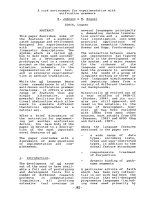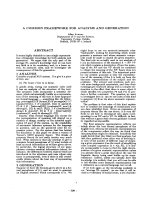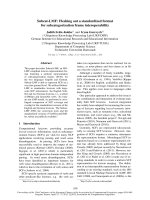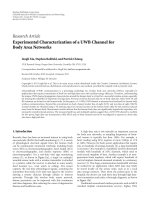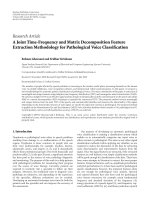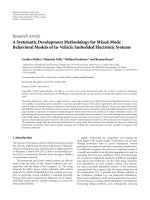HYDROPONICS – A STANDARD METHODOLOGY FOR PLANT BIOLOGICAL RESEARCHES potx
Bạn đang xem bản rút gọn của tài liệu. Xem và tải ngay bản đầy đủ của tài liệu tại đây (15.79 MB, 254 trang )
HYDROPONICS –
A STANDARD
METHODOLOGY FOR
PLANT BIOLOGICAL
RESEARCHES
Edited by Toshiki Asao
Hydroponics – A Standard Methodology for Plant Biological Researches
Edited by Toshiki Asao
Published by InTech
Janeza Trdine 9, 51000 Rijeka, Croatia
Copyright © 2012 InTech
All chapters are Open Access distributed under the Creative Commons Attribution 3.0
license, which allows users to download, copy and build upon published articles even for
commercial purposes, as long as the author and publisher are properly credited, which
ensures maximum dissemination and a wider impact of our publications. After this work
has been published by InTech, authors have the right to republish it, in whole or part, in
any publication of which they are the author, and to make other personal use of the
work. Any republication, referencing or personal use of the work must explicitly identify
the original source.
As for readers, this license allows users to download, copy and build upon published
chapters even for commercial purposes, as long as the author and publisher are properly
credited, which ensures maximum dissemination and a wider impact of our publications.
Notice
Statements and opinions expressed in the chapters are these of the individual contributors
and not necessarily those of the editors or publisher. No responsibility is accepted for the
accuracy of information contained in the published chapters. The publisher assumes no
responsibility for any damage or injury to persons or property arising out of the use of any
materials, instructions, methods or ideas contained in the book.
Publishing Process Manager Romina Skomersic
Technical Editor Teodora Smiljanic
Cover Designer InTech Design Team
First published March, 2012
Printed in Croatia
A free online edition of this book is available at www.intechopen.com
Additional hard copies can be obtained from
Hydroponics – A Standard Methodology for Plant Biological Researches,
Edited by Toshiki Asao
p. cm.
ISBN 978-953-51-0386-8
Contents
Preface IX
Chapter 1 Nutrient Solutions for Hydroponic Systems 1
Libia I. Trejo-Téllez and Fernando C. Gómez-Merino
Chapter 2 Parameters Necessary for In Vitro
Hydroponic Pea Plantlet Flowering and Fruiting 23
Brent Tisserat
Chapter 3 The Use of Hydroponics in
Abiotic Stress Tolerance Research 39
Yuri Shavrukov, Yusuf Genc and Julie Hayes
Chapter 4 Autotoxicity in Vegetables
and Ornamentals and Its Control 67
Toshiki Asao and Md. Asaduzzaman
Chapter 5 Plant Hydroponic Cultivation:
A Support for Biology Research in the
Field of Plant-Microbe-Environment Interactions 101
Haythem Mhadhbi
Chapter 6 The Role of Hydroponics Technique
as a Standard Methodology in Various
Aspects of Plant Biology Researches 113
Masoud Torabi, Aliakbar Mokhtarzadeh
and Mehrdad Mahlooji
Chapter 7 The Use of Hydroponic Growth
Systems to Study the Root and
Shoot Ionome of Arabidopsis thaliana 135
Irina Berezin, Meirav Elazar, Rachel Gaash,
Meital Avramov-Mor and Orit Shaul
Chapter 8 Understanding Root Uptake of Nutrients,
Toxic and Polluting Elements in Hydroponic Culture 153
J-T. Cornelis, N. Kruyts, J.E. Dufey, B. Delvaux and S. Opfergelt
VI Contents
Chapter 9 Hydroponics and Environmental Clean-Up 181
Ulrico J. López-Chuken
Chapter 10 Hydroponic Cactus Pear Production,
Productivity and Quality of Nopalito and Fodder 199
Hugo Magdaleno Ramírez-Tobías, Cristian López-Palacios,
Juan Rogelio Aguirre-Rivera and Juan Antonio Reyes-Agüero
Chapter 11 Hydroponic Production of Fruit Tree Seedlings in Brazil 225
Ricardo Monteiro Corrêa, Sheila Isabel do Carmo Pinto,
Érika Soares Reis and Vanessa Andalo Mendes de Carvalho
Preface
Hydroponics is a method of growing plants using mineral nutrient solutions, in water,
without soil. In this system plant can be grown with their roots in the mineral nutrient
solution only or in an inert medium, such as perlite, gravel, mineral wool, or coconut
husk. It is possibly the most intensive method of crop production providing efficient
use of water and mineral nutrients with the minimal use of space. It has been used
successfully by the commercial grower for fast-growing horticultural crops such as
lettuce, strawberries, tomatoes, cucumbers and ornamentals. Indeed this technology
enables a more precise control of growth conditions which make easier to study the
variables factors or parameters. Specialty of this technique is the vigorous
development of root system and efficient uptake of the essential nutrients from culture
solution resulting better crop yield. However, this managed culture system is limited
to high initial investment and constant energy input. Therefore, hydroponic
technology gained popularity for producing high value crops in developed countries
such as the United States, Canada, Europe and Japan.
This book is targeted at commercial fruit and vegetable growers who are thinking of
making the transition to hydroponic cultivation but are unsure of the issues they need
to consider. It describes the different types of hydroponic cultivation, compositions
and properties of nutrient solution used. This work is mainly devoted to describing
use of hydroponic method in various biological studies. The use of hydroponics in
producing functional food in aseptic condition or ornamental plant production,
studying plant responses to different biotic and abiotic stresses are described in detail.
Production constraints developed though reuse of culture solution in a closed system
and their overcoming means are also included. This book will provide much valuable
information for the commercial grower, researchers, and the students.
The publication would have been impossible without the dedication and hard work of
many researchers around the globe. All acknowledgements go to the authors of these
chapters, who volunteered their valuable time to contribute to this book.
Dr. Toshiki Asao
Department of Agriculture, Faculty of Life and Environmental Science,
Shimane University, Kamihonjo, Matsue, Shimane
Japan
1
Nutrient Solutions for Hydroponic Systems
Libia I. Trejo-Téllez and Fernando C. Gómez-Merino
Colegio de Postgraduados, Montecillo, Texcoco, State of Mexico
Mexico
1. Introduction
Hydroponic crop production has significantly increased in recent years worldwide, as it
allows a more efficient use of water and fertilizers, as well as a better control of climate and
pest factors. Furthermore, hydroponic production increases crop quality and productivity,
which results in higher competitiveness and economic incomes.
Among factors affecting hydroponic production systems, the nutrient solution is considered
to be one of the most important determining factors of crop yield and quality. This chapter
aims to explain aspects related to plant nutrition and its effects on production of hydroponic
crops, considering basic aspects such as nutrient solutions and their development through
the years; components of nutrient solutions (macro and micronutrients), taking into account
criteria of nutrimental essentiality in higher plants and their classification, as well as a brief
description of their functions in plants; we define the concept of benefic element and its
classification, and cite some examples of their addition to nutrient solutions. The concept of
pH of the nutrient solution is also defined, as well as its effect on nutrimental availability;
osmotic potential of the nutrient solution and its relationship with electric conductivity are
discussed, besides their used units and their equivalences, and the influence of both factors
on the nutrient uptake in plants; we highlight the importance of oxygenation in the nutrient
solution; climate factors affecting nutrient solutions behaviour are also reported,
emphasizing on temperature; formulation and preparation of nutrient solutions considering
different fertilizer sources and water quality are described as well; finally, we raise topics
related to the management of nutrient solutions depending on the species nutrimental needs
and on the hydroponic system used, including flow diagrams and figures that facilitate
readers comprehension of concepts and principles. Therefore, this chapter aims to be a
practical guide to those interested in hydroponic crops, with a strong theoretical support.
2. Nutrient solution
A nutrient solution for hydroponic systems is an aqueous solution containing mainly
inorganics ions from soluble salts of essential elements for higher plants. Eventually, some
organic compounds such as iron chelates may be present (Steiner, 1968). An essential
element has a clear physiological role and its absence prevents the complete plant life cycle
(Taiz & Zeiger, 1998). Currently 17 elements are considered essential for most plants, these
are carbon, hydrogen, oxygen, nitrogen, phosphorus, potassium, calcium, magnesium,
sulphur, iron, copper, zinc, manganese, molybdenum, boron, chlorine and nickel (Salisbury
Hydroponics – A Standard Methodology for Plant Biological Researches
2
& Ross, 1994). With the exception of carbon (C) and oxygen (O), which are supplied from
the atmosphere, the essential elements are obtained from the growth medium. Other
elements such as sodium, silicon, vanadium, selenium, cobalt, aluminum and iodine among
others, are considered beneficial because some of them can stimulate the growth, or can
compensate the toxic effects of other elements, or may replace essential nutrients in a less
specific role (Trejo-Téllez et al., 2007). The most basic nutrient solutions consider in its
composition only nitrogen, phosphorus, potassium, calcium, magnesium and sulphur; and
they are supplemented with micronutrients.
The nutrient composition determines electrical conductivity and osmotic potential of the
solution. Moreover, there are other parameters that define a nutrient solution as discussed
below in detail.
2.1 pH of the nutrient solution
The pH is a parameter that measures the acidity or alkalinity of a solution. This value
indicates the relationship between the concentration of free ions H
+
and OH
-
present in a
solution and ranges between 0 and 14.
In soil, the Troug diagram illustrates the pH effect on the availability of nutrients to plants
(Fig. 1). Similarly, changing the pH of a nutrient solution affects its composition, elemental
speciation and bioavailability. The term “speciation” indicates the distribution of elements
among their various chemical and physical forms like: free ions, soluble complexes, chelates,
ion pairs, solid and gaseous phases and different oxidation states (De Rijck & Schrevens,
1998a).
An important feature of the nutrient solutions is that they must contain the ions in solution
and in chemical forms that can be absorbed by plants, so in hydroponic systems the plant
productivity is closely related with to nutrient uptake and the pH regulation (Marschner,
1995). Each nutrient shows differential responses to changes in pH of the nutrient solution
as described below.
In the nutrient solution, NH
3
only forms a complex with H
+
. For a pH range between 2 and
7, NH
3
is completely present as NH
4
+
(Fig. 2). Increasing the pH above 7 the concentration of
NH
4
+
decreases, while the concentration of NH
3
augments (De Rijck & Schrevens, 1999).
Tyson et al. (2007) in a study to determine the nitrification rate response in a perlite trickling
biofilter (root growth medium) exposed to hydroponic nutrient solution, varying NO
3
-
concentrations and two pH levels (6.5 and 8.5), founded that nitrification was significantly
impacted by water pH. The increased ammonia oxidation rate (1.75) compared to nitrite
oxidation rate (1.3) at pH 8.5 resulted in accumulation of NO
2
−
to levels near those harmful
to plants (observed peak of 4.2 mg L
-1
NO
2
−
). The potential for increased levels of un-ionized
ammonia, which reduced plant nutrient uptake from micronutrient precipitation, are
additional problems associated with pH 8.5.
Phosphorus is an element which occurs in forms that are strongly dependent on
environment pH. In the root zone this element can be found as PO
4
3-
, HPO
4
2-
, and H
2
PO
4
-
ions; the last two ions are the main forms of P taken by plants. On inert substrates, the
largest amount of P available in a nutrient solution is presented when its pH is slightly
acidic (pH 5). In alkaline and highly acidic solutions the concentration of P decreases in a
Nutrient Solutions for Hydroponic Systems
3
Fig. 1. Troug diagram of nutrient availability. Each nutrient is represented with a band; the
thickness is proportional to the availability.
Hydroponics – A Standard Methodology for Plant Biological Researches
4
Fig. 2. Ammoniacal speciation in function of pH.
significant way (Dyśko et al., 2008). Namely, with pH 5, 100% of P is present as H
2
PO
4
-
; this
form converts into HPO
4
-2
at pH 7.3 (pKa2), reaching 100% at pH 10. The pH range that
dominates the ion H
2
PO
4
-2
on HPO
4
-
is between 5 and 6 (De Rijck & Schrevens, 1997). The
pH-dependent speciation of P is showed in Fig. 3.
Potassium is almost completely present as a free ion in a nutrient solution with pH values
from 2 to 9; only small amounts of K
+
can form a soluble complex with SO
4
-2
or can be bound
to Cl
-
(De Rijck & Schrevens, 1998a). Like potassium, calcium and magnesium are available to
plants in a wide range of pH; however, the presence of other ions interferes in their availability
due to the formation of compounds with different grade of solubility. As water naturally
contains HCO
3
-
, this anion turns into CO
3
-2
when the pH is higher than 8.3 or to H
2
CO
3
when it
is less than 3.5; the H
2
CO
3
is in chemical equilibrium with the carbon dioxide in the
atmosphere. Thus at a pH above 8.3, Ca
2+
and Mg
2+
ions easily precipitate as carbonates (Ayers
& Westcot, 1987). Also, as mentioned above, when the pH of the nutrient solution increases,
the HPO
4
2-
ion predominates, which precipitates with Ca
2+
when the product of the
concentration of these ions is greater than 2.2, expressed in mol m
-3
(Steiner, 1984). Sulphate
also forms relatively strong complexes with Ca
2+
and Mg
2+
(De Rijck & Schrevens, 1998b). As
pH increases from 2 to 9, the amount of SO
4
2-
, forming soluble complexes with Mg
2+
as MgSO
4
and with K
+
as KSO
4
-
increases (De Rijck & Schrevens, 1999).
Iron, copper, zinc, boron, and manganese, become unavailable at pH higher than 6.5
(Timmons et al., 2002; Tyson, 2007). In Triticum aestivum, the manganese precipitation on
root surfaces was correlated with a plant-induced rise in pH of culture above 5.5 (Macfie &
Nutrient Solutions for Hydroponic Systems
5
Fig. 3. Speciation of P depending on pH.
Taylor, 1989). Boron is mainly uptaken by plants as boric acid, which is not dissociated until
pH is close to 7; to greater pH values, boric acid accepts hydroxide ions to form anionic
species (Tariq & Mott, 2007) (Fig. 4).
Therefore, nutrient availability for plant uptake at pH above 7 may be restricted due to
precipitation of Fe
2+
, Mn
2+
, PO
3
−4
, Ca
2+
and Mg
2+
to insoluble and unavailable salts (Resh,
2004). The proper pH values of nutrient solution for the development of crops, lies between
5.5 and 6.5.
2.2 Electrical conductivity of the nutrient solution
The total ionic concentration of a nutrient solution determines the growth, development and
production of plants (Steiner, 1961). The total amount of ions of dissolved salts in the
nutrient solution exerts a force called osmotic pressure (OP), which is a colligative property
of the nutrient solutions and it is clearly dependent of the amount of dissolved solutes
(Landowne, 2006). Also, the terms solute potential or osmotic potential are widely used in
nutrient solution, which represent the effect of dissolved solutes on water potential; solutes
reduce the free energy of water by diluting the water (Taiz & Zeiger, 1998). Thus, the terms
osmotic pressure and osmotic potential can be used interchangeably, still important
considering the units that are used, commonly atm, bar and MPa (Sandoval et al., 2007).
An indirect way to estimate the osmotic pressure of the nutrient solution is the electrical
conductivity (EC), an index of salt concentration that defines the total amount of salts in a
solution. Hence, EC of the nutrient solution is a good indicator of the amount of available
Hydroponics – A Standard Methodology for Plant Biological Researches
6
Fig. 4. Transformation of boric acid (black circles) and anion forms of boric acid (white
circles) as a function of pH (Bishop et al., 2004).
ions to the plants in the root zone (Nemali & van Iersel, 2004). Estimation of the osmotic
pressure of a nutrient solution from EC can be done by using the following empirical
relations (Sandoval, 2007):
OP (atm) = 0.36 X EC (in dS m
-1
at 25
o
C)
OP (bar) = ̶ 0.36 X EC (in dS m
-1
at 25
o
C)
OP (MPa) = OP (bars) X 0.1
The ions associated with EC are Ca
2+
, Mg
2+
, K
+
, Na
+
, H
+
, NO
3
-
, SO
4
2-
, Cl
-
, HCO
3
-
, OH
-
(United States Departament of Agriculture [USDA], 2001). The supply of micronutriments,
namely Fe, Cu, Zn, Mn, B, Mo, and Ni, are very small in ratio to the others elements
(macronutrients), so it has no a significant effect on EC (Sonneveld &Voogt, 2009).
The ideal EC is specific for each crop and dependent on environmental conditions
(Sonneveld &Voogt, 2009); however, the EC values for hydroponic systems range from 1.5
to 2.5 ds m
-1
. Higher EC hinders nutrient uptake by increasing osmotic pressure, whereas
lower EC may severely affect plant health and yield (Samarakoon et al., 2006). The decrease
in water uptake is strongly and linearly correlated to EC (Dalton et al., 1997). Table 1 shows
the classification of crops in function of salinity tolerance.
As noted in Table 1, some crops can grow with high levels of EC and even a proper
management of EC of the nutrient solution can provide and effective tool to improve
Nutrient Solutions for Hydroponic Systems
7
Salinity group
Threshold EC,
dS m
-1
Example of crops
Sensitive 1.4 lettuce, carrot, strawberry, onion
Moderately sensitive 3.0 broccoli, cabbage, tomato, cucumber,
radish, pepper
Moderately tolerant 6.0 soybean, ryegrass
Tolerant 10.0 bermuda-grass, sugarbeet, cotton
Table 1. Threshold EC for salinity groups and example of crops (Jensen, 1980; Tanji, 1990).
vegetable quality (Gruda, 2009). In particular, parameters of fruit quality such as soluble
solids content, titratable acidity and dry matter augmented by increasing EC level of
nutrient solution from 2 to 10 dS m
-1
. As a consequence, deep sea water (DSW) is being used
for nutrient solution due to its high amount of Na
+
, Mg
2+
, K
+
and Ca
2+
(Chadirin et al., 2007).
2.3 Composition of the nutrient solution
As previously stated, nutrient solutions usually contain six essential nutrients: N, P, S, K, Ca
and Mg. Thereby Steiner created the concept of ionic mutual ratio which is based on the
mutual ratio of anions: NO
3
-
, H
2
PO
4
-
and SO
4
2-
, and the mutual ratio of cations K
+
, Ca
2+
,
Mg
2+
. Such a relationship is not just about the total amount of each ion in the solution, but in
the quantitative relationship that keep the ions together; if improper relationship between
them take place, plan performance can be negatively affected(Steiner, 1961, 1968).
In this way, the ionic balance constraint makes it impossible to supply one ion without
introducing a counter ion. A change in the concentration of one ion must be accompanied by
either a corresponding change for an ion of the opposite charge, a complementary change
for other ions of the same charge, or both (Hewitt, 1966).
When a nutrient solution is applied continuously, plants can uptake ions at very low
concentrations. So, it has been reported than a high proportion of the nutrients are not used
by plants or their uptake does not impact the production. For example, it was determined
that in anthurium, 60% of nutrients are lost in the leachate (Dufour & Guérin, 2005); but in
closed systems, however, the loss of nutrients from the root environment is brought to a
minimum (Voogt, 2002). Also it has been shown that the concentration of nutrient solution
can be reduced by 50% without any adverse effect on biomass and quality in gerbera (Zheng
et al., 2005) and geranium (Rouphael et al., 2008). Accordingly, Siddiqi et al. (1998) reported
no adverse effect on growth, fruit yield and fruit quality in tomato when reduction of
macronutrient concentrations to 50% of the control level as well as cessation of
replenishment of the feed solution for 16 days after 7 months of growth at control levels
were applied. However, it is expected that in particular situations, too low concentrations do
not cover the minimum demand of certain nutrients.
On the other hand, high concentrated nutrient solutions lead to excessive nutrient uptake and
therefore toxic effects may be expected. Conversely, there are evidences of positive effects of
high concentrations of nutrient solution. In salvia, the increase of Hoagland concentration at
200% caused that plants flowered 8 days previous to the plants at low concentrations,
increasing total dry weight and leaf area (Kang & van Iersel, 2004). Likewise, high levels of K
+
Hydroponics – A Standard Methodology for Plant Biological Researches
8
in the nutrient solution (14.2 meq L
-1
vs 3.4 meq L
-1
) increased fruit dry matter, total soluble
solids content and lycopene concentration of tomato (Fanasca et al., 2006).
The explanation of these apparent controversial responses is the existence of optimal
concentrations of certain nutrients in a solution for a culture under special environmental
conditions as well as their relative proportions and not their absolute concentrations as
determining factors (Juárez et al., 2006). In order to prevent contradictory observations,
Dufour & Guérin (2005) recommend: a) to monitor the availability of nutrients through
changes in the ionic composition of the substrate by analysis of percolate, and b) to asses
plant nutrient uptake by nutrient content analysis in leaves. Moreover, Voogt (2002)
indicates that the nutrient solution composition must reflect the uptake ratios of individual
elements by the crop and as the demand between species differs, the basic composition of a
nutrient solution is specific for each crop. It must also be taken into account that the uptake
differs between elements and the system used. For instance, in open-systems with free
drainage, much of the nutrient solution is lost by leachate.
There are several formulations of nutrient solutions. Nevertheless, most of them are
empirically based. Table 2 comprises some of them.
Nutrient
Hoagland & Arnon
(1938)
Hewitt
(1966)
Cooper (1979) Steiner (1984)
mg L
-1
N 210 168 200-236 168
P 31 41 60 31
K 234 156 300 273
Ca 160 160 170-185 180
Mg 34 36 50 48
S 64 48 68 336
Fe 2.5 2.8 12 2-4
Cu 0.02 0.064 0.1 0.02
Zn 0.05 0.065 0.1 0.11
Mn 0.5 0.54 2.0 0.62
B 0.5 0.54 0.3 0.44
Mo 0.01 0.04 0.2 Not considered
Table 2. Concentration ranges of essential mineral elements according to various authors
(adapted from Cooper, 1988; Steiner, 1984; Windsor & Schwarz, 1990).
2.4 Temperature of the nutrient solution
The temperature of the nutrient solution influences the uptake of water and nutrients
differentially by the crop.
Two nutrient solution temperatures (cold and warm solution, 10 and 22 °C, respectively)
were evaluated during two flowering events of rose plants (Rosa × hybrida cv. Grand Gala).
Nutrient Solutions for Hydroponic Systems
9
Generally, cold solution increased NO
3
−
uptake and thin-white roots production, but
decreased water uptake. Nutrient solution temperature also had an effect on the
photosynthetic apparatus. In general terms, the effective quantum yield and the fraction of
open PSII reaction centres were higher in rose plants grown at cold solution (Calatayud et
al., 2008).
In spinach seedlings, three temperatures of irrigation water (24, 26 and 28 °C) were
evaluated during 8 weeks. Leaf length, leaf number and total fresh and dry biomass weights
per plant were higher in plants grown at elevated temperatures, with optimum growth
being recorded at 28 °C (Nxawe et al., 2009).
In tomato plants, rates of water and nutrients uptake by roots (which varied depending on
solar radiation) were studied. High solution temperature (35 °C) produced effects in the
short and long-term. In the short-term, water and nutrients uptake were activated through a
decrease in water viscosity, and membrane transport was affected. In the long term, oxygen
solubility was reduced, while enzymatic oxidization of phenolic compounds in root
epidermal and cortex tissues were stimulated, but nutrient concentration in root xylem sap
diminished, and the root xylem sap concentration of N, K, Ca became lower than those in
the nutrient solution (Falah et al., 2010).
Graves (1983) observed that at temperatures below 22 °C the dissolved oxygen in the
nutrient solution is sufficient to cover the demand of this element in tomato plants.
Nevertheless, the requirement diminished as a consequence of a reduction in a number of
physiological processes, including respiration, which further impacts plant growth.
Conversely, temperatures over 22 °C, oxygen demand is not covered by the nutrient
solution as higher temperatures increase the diffusion of this gas. At high temperatures of
the nutrient solution an increased vegetative growth to a greater extent than desirable is
observed, which reduces fructification.
To assess the importance of temperature on the solubility of oxygen, Table 3 depicts data for
temperatures that are usually filed within greenhouses, so that temperature has a direct
relationship to the amount of oxygen consumed by the plant and reverse relationship with
dissolved oxygen from the nutrient solution.
Temperature,
o
C Oxygen solubility, mg L
-1
of pure water
10 11.29
15 10.08
20 9.09
25 8.26
30 7.56
35 6.95
40 6.41
45 5.93
Table 3. Solubility of oxygen in water pure at various temperatures at 760 mm Hg of
atmospheric pressure.
Hydroponics – A Standard Methodology for Plant Biological Researches
10
3. Nutrient solution management
Soilless cultivation allows a more accurate control of environmental conditions that offers
possibilities for increasing production and improving quality of crops. In particular, in the
nutrient solution parameters such as temperature, pH, electrical conductivity, oxygen
content, among others can be manipulated. If these parameters are not controlled properly
and in timing, advantage can be translated into disadvantages. Then, several ways to control
some parameters of the nutrient solution are to be reviewed in the following.
3.1 pH regulation
As mentioned above, the pH value determines the nutrient availability for plants.
Accordingly, its adjustment must be done daily due to the lower buffering capacity of
soilless systems (Urrestarazu, 2004).
The changes in the pH of a nutrient solution depending on the difference in the magnitude
of nutrient uptake by plants, in terms of the balance of anions over cations. When the anions
are uptaken in higher concentrations than cations, for example nitrate, the plant excretes
OH
-
or HCO
3
-
anions, to balance the electrical charges inside, which produces increasing in
the pH value. This process is called physiological alkalinity (Marschner, 1995).
Hence, incorporation of ammonium as N source in the nutrient solution regulates the pH
and therefore nutrient availability is ensured. Breteler & Smit (1974) reported that
ammonium depressed the pH of nutrient solution even in the presence of nitrate. In rose
plants, the addition of ammonium in a nutrient solution containing nitrate produced a total
nitrogen uptake increase during shoot elongation; and an increase in P concentration in the
roots (Lorenzo et al., 2000). The proportion of total nitrogen is added to the nutrient solution
as ammonium is dependent on the crop.
On other hand, the chemical adjustment is widely used, namely the addition of acids to
reduce the pH value. The pH is closely related to the concentration of HCO
3
-
and CO
3
2-
;
when an acid is applied, the CO
3
2-
ion is transformed to HCO
3
-
, and then HCO
3
-
is converted
into H
2
CO
3
. Carbonic acid is partially dissociated in H
2
O and CO
2
(De Rijck & Schrevens,
1997). Regulation of pH is normally carried out by using nitric, sulphuric or phosphoric
acid, and such acids can be used either individually or combined.
3.2 Electrical conductivity management
Electrical conductivity (EC) is modified by plants as they absorb nutrients and water from
the nutrient solution. Therefore, a decrease in the concentration of some ions is and an
increase in the concentration of others is observed simultaneously, both in close and open
systems. For example, in a closed hydroponic system with a rose crop, the composition of
the nutrient solution in the tank was measured. It was observed that the concentration of Fe
decreased very fast, while that of Ca
2+
, Mg
2+
and Cl
-
increased; moreover, concentrations of
K
+
, Ca
2+
and SO
4
2-
did not reach critical levels (Lykas et al., 2001). Instead, in an open system
with recirculation of nutrient solution, an increase in the EC value due to the accumulation
of high levels of some ions like bicarbonates, sulphates and chlorides is observed (Zekki et
al. 1996). So, the recycling of nutrient solution represents a point of discussion. Moreover,
the substrates can retain ions and consequently the EC increases. To reduce the salt
Nutrient Solutions for Hydroponic Systems
11
accumulation in substrates, the controlled leaching with water of good quality is an
alternative (Ansorena, 2004). The use of mulching with polyethylene or polypropylene sheet
reduces the water consumption, increases the calculated water use efficiency and decreases
the EC of the substrate; so the mulching is an alternative to control of EC too (Farina et al.,
2003).
On the one hand, positive evidences of nutrient solutions reuse are reported, which
necessarily involves regulation of the EC. Therefore, recycling and reuse of solutions is a
trend in searching for sustainable agricultural production systems (Andriolo et al., 2006).
Brun et al. (2001) reported recycling systems based on EC control, consisting of adding a
water complement to the drainage to decrease the EC and a complement nutrient solution to
obtain the desired EC. Carmassi et al. (2003) developed a simple model for the changes in
ion concentration and EC of recirculating nutrient solution in closed-loop soilless culture on
the basis of balance equation for nutrient uptake by hydroponically-grown plants. In this
model, the crop evapotranspiration is compensated by refilling the mixing tank with
complete nutrient solution.
Recently, an in situ optimal control method of nutrient solution composition has been
proposed. Instead of modeling the correlations between greenhouse vegetable growth and
nutrient solution, this method is based on Q-learning searches for optimal control policy
through systematic interaction with the environment (Chen et al., 2011).
Even though, Bugbee (2004) indicates that the monitoring ions in solution is not always
necessary. In fact, the rapid depletion of some nutrients often causes people to add toxic
amounts of nutrients to the solution. Besides, it has been demonstrated the existence of a
wide cultivable microbial community in the nutrient solution before recycling and
recirculation, which supports the necessity of disinfecting nutrient solutions used in soilless
cultivation systems, during the recycling process, in order to ensure crop sanitation and
avoiding plant disease spreading (Calmin et al., 2008).
3.3 Temperature control
The temperature of the nutrient solution has a direct relation to the amount of oxygen
consumed by plants, and an inverse relation to the oxygen dissolved in it, as it was
previously indicated. Temperature also affects solubility of fertilizer and uptake capacity of
roots, being evident the importance of controlling this variable especially in extreme
weathers. Each plant species has a minimum, optimum, and maximum temperature for
growth, which requires the implementation of heating or cooling systems for balancing the
nutrient solution temperature.
The underground water pipe system for energy-saving control of nutrient solution
temperature consists of a large-sized pipe filled with water under the ground, and a unit for
circulating the nutrient solution between the cultivation bed and the underground water
pipe. The temperature condition in the underground water pipe 1.5 m below the ground
surface is stable as compared to that in greenhouses which excessively high temperatures in
summer and low in winter. During the circulation, heat can be exchanged between the
nutrient solution and the water stored in the underground water pipe. Furthermore, this
circulation warmed the nutrient solution excessively chilled in cold winter nights (Hidaka et
al., 2008).
Hydroponics – A Standard Methodology for Plant Biological Researches
12
Nam et al. (1996) evaluated the cooling capacities of three different systems, which used
either polyethylene or stainless tube in the solution tank, or a counter flow type with double
pipes, having 41, 70 or 81% of cooling load in a hydroponic greenhouse, respectively.
Villela et al. (2004) evaluated the cooling of the nutrient solution at about 12 °C by using a
heating exchange device on the productivity of two varieties of strawberry. The cooling of
the nutrient solution conferred better productivity of Sweet Charlie variety; whilst it didn't
cause any effects over the Campinas variety.
As stated above, deep sea water (DSW) can be used in the preparation of nutrient solutions
due to its nutrient content. Likewise, it is one alternative for nutrient cooling systems in hot
season due to its low temperature. Cold DSW pumped inside pipe through cultivation bed
might decrease temperature of nutrient solution by heat exchange between nutrient solution
and DSW. For environment reason, after being used for cooling system, DSW that contained
abundant nutrient can be used as nutrient supplement for tomato plant by diluting into
standard nutrient solution. It is suggested that DSW might increase fruit quality because of
its enrichment of nutrient solution (Chadirin et al., 2006).
3.4 Oxygenation of nutrient solution
The consumption of O
2
increases when the temperature of nutrient solution increases too.
Consequently, it produces an increase in the relative concentration of CO
2
in the root
environment if the root aeration is not adequate (Morard & Silvestre, 1996).
The concentration of oxygen in the nutrient solution also depends on crop demand, being
higher when the photosynthetic activity increases (Papadopoulous et al., 1999). A decrease
bellow 3 or 4 mg L
-1
of dissolved oxygen, inhibits root growth and produces changes to a
brown color, which can be considered as the first symptom of the oxygen lack (Gislerød &
Kempton, 1983).
Nonetheless, substrates under long cultivation periods usually present increase of organic
matter content and microorganism activity, which could lead to an increase of the
competition for oxygen in the root environment. Yet, roots are densely matted within the
substrate, which alters diffusion and supply of oxygen (Bonachela et al., 2010).
The supply of pure, pressurized oxygen gas to the nutrient solution is an oxygen-enriched
method often used for research purposes, and it is called oxyfertigation (Chun & Takakura,
1994).
Bonachela et al. (2010) evaluated the response to oxygen enrichment of nutrient solution in
of autumn-winter sweet pepper and spring melon crops grown on rockwool slabs and
perlite grow-bags, compared to non-enriched crops. The pressurized oxygen gas was
dissolved in the nutrient solution during each irrigation with a gas injector within the
irrigation pipe. The use of inexpensive systems of substrate oxygen enrichment should be
restricted to rockwool substrates and to crop periods when a high oxygen demand coincides
with low oxygen availability, such as the period from melon flowering phase.
The supply of potassium peroxide as an oxygen generator on vegetable crops grown in
commercial substrates once a week was evaluated in sweet pepper, melon and cucumber.
Results indicated that the application of potassium peroxide at a concentration of 1 g L
-1
is the
Nutrient Solutions for Hydroponic Systems
13
best fraction to use in soilless culture. The treatment with potassium peroxide increases the
yield of sweet pepper and melon in 20 and 15% respectively, in comparison to the control,
whereas there was no significant difference in cucumber yield (Urrestarazu & Mazuela, 2005).
4. Preparation of nutrient solution
4.1 Nutrient solution design
Hansen (1978) indicates that the addition of plant nutrients to hydroponic systems may be
performed according to the plant nutrient requirement. Application of nutrients may be
performed according to analyses of a specific crop stage that may describe the consumption
of the various typical nutrients of the particular crop or by means of analyses of the total
plant needs quantitatively adjusted to the rate of growth and the amounts of water supplied.
Thus, the composition and concentration of the nutrient solution are dependent on culture
system, crop development stage, and environmental conditions (Coic, 1973; Steiner, 1973).
Likewise, Steiner (1968) proposed that in soilless cultures any ionic ratio and any total
concentration of ions can be given, as precipitation limits for certain combinations of ions
are considered. Thus, the selection the concentration of a nutrient solution should be such
that water and total ions are absorbed by the plant in the same proportion in which those
are present in the solution.
Steiner (1961) developed a method to calculate a formula for the composition of a nutrient
solution, which satisfies certain requirements. Later on he evaluated five different ratios of
NO
3
-
:anions (NO
3
-
+H
2
PO
4
-
+SO
4
2-
) and three of K
+
:cations (K
+
+Ca
2+
+Mg
2+
), combining also the
two groups, resulting in a full factorial design (Fig. 5); all solutions had the same osmotic
pressure and pH value. In this system, the relative concentration of K
+
increases at the expense
of Ca
2+
andMg
2+
concentrations. Furthermore, the ratio 3:1 between Ca
2+
and Mg
2+
is constant.
Similarly, the ratio H
2
PO
4
-
:SO
4
2-
(1:9) is constant, while the changes in the NO
3
-
concentration
are produced at expense of the H
2
PO
4
-
and SO
4
2
- concentrations (Steiner, 1966).
On the other hand, Van Labeke et al. (1995) studied Eustoma grandiflorum responses to
different nutrient solutions differing in ion ratios using an experimental as a {3.1} simplex
centroid design, one in the cation factor-space and the other in the anion factor-space, which
is depicted in Fig. 6. Then, De Rijck & Schrevens (1998c) investigated the effects of the
mineral composition of the nutrient solution and the moisture content of the substrate on
the mineral content of hydroponically grown tomato fruits, using “design and analysis of
mixture systems“, a {3.1} simplex lattice design extended with the overall centroid set-up in
the cation factor-space (K
+
, Ca
2+
and Mg
2+
) of the nutrient solution. For each nutritional
composition two moisture contents (40 and 80% of volume) of the substrates were
investigated.
After this short sample illustrates some aspects to be considered in the preparation of
nutrient solutions.
4.2 Water quality
According to Tognoni et al. (1998), water quality in hydroponics can be limited to the
concentrations of specific ions and phytotoxic substances relevant for plant nutrition as well
as the presence of organisms and substances that can clog the irrigation systems.
Hydroponics – A Standard Methodology for Plant Biological Researches
14
Fig. 5. Proposed ratios NO
3
-
:anions (NO
3
-
+H
2
PO
4
-
+SO
4
2-
) (a) and K
+
:cations (K
+
+Ca
2+
+Mg
2+
)
(b) by Steiner (1966).
Nutrient Solutions for Hydroponic Systems
15
Fig. 6. Experimental {3.1} simplex centroid design used by Van Lecke et al. (2006).
Regarding the presence of organisms both in water for preparing nutrient solution and in
recirculating nutrient solution, its control can be achieved by heat treatment, UV radiation
and membrane filtration. However, cheaper chemical treatments as sodium hypochlorite,
chlorine dioxide and copper silver ionization may partly solve the pathogen problem; with
the disadvantages that introduce a potential accumulation of other elements in closed
systems (van Os, 2010).
It is necessary to carry out a chemical analysis of water to be used in the nutrient solution.
Knowing the kind and concentration of ions allows identifying on the one hand, those that
are needed in the nutrient solution and therefore can be subtracted from the original
formulation; and on the other hand, to take decisions about ions not needed in the nutrient
solution.
As previously mentioned, DSW can be used for preparing nutrient solutions. Chadirin et al.
(2007) reported that plants treated with circulated water having an EC of 20 dS m
-1
produced tomatoes with highest soluble solids, 8.0% Brix or increased yield in 30% in
comparison to the control. Nevertheless, Pardossi et al. (2008) showed that nutrient solution
with high EC (9 dS m
-1
) had no important effects on both crop yield and fruit quality.
4.3 Fertilizer source for nutrient solution
Table 4 has a list of commonly used fertilizers and acids in hydroponics, as well as some
characteristics of interest for plant nutrition applications.

